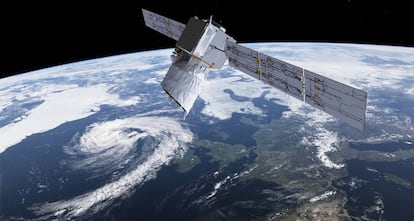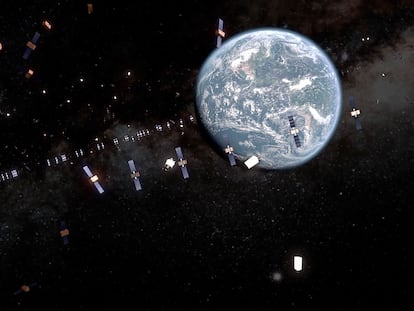Latest solar superstorm blinded the systems that prevent satellites from crashing in space
A study has tracked the mass migration of 5,000 satellites following the intense cosmic event of May 10, which made their trajectories unpredictable for several days

The largest geomagnetic storm in more than 20 years left a very unusual natural spectacle between May 10 and 12, overlapping with the Northern Lights in a handful of European countries. This storm caused an artificial phenomenon that had never happened before. For the first time — according to a preliminary study by scientists at the Massachusetts Institute of Technology (MIT) — the arrival of an intense gust of solar wind in low Earth orbit (LEO) triggered the migration of half of all active satellites. And, as the Sun is in its most active phase, it’s possible that storms like that one will be repeated in 2024 and 2025.
The authors of the study warn that, during the days of the storm and the subsequent period, a number of unforeseen movements disabled the safety systems designed to prevent collisions in LEO. In that area of space which surrounds our planet — up to a height of 621 miles — there are both the two space stations (where Western astronauts and Chinese taikonauts live), as well as a multitude of satellites that deal with scientific observation, navigation and telecommunications. Among them are the more than 6,200 Starlink satellites belonging to Elon Musk’s SpaceX company, intended to provide global high-speed internet coverage.
The rapid proliferation of these types of devices is the great change in LEO since the previous solar superstorm, which occurred in October 2003, when there were barely 850 active satellites. Today, there are more than 10,000. Their mass launch began in 2019. Since then, they’ve been changing how the night sky appears to the naked eye. Astronomers have also warned that they interfere with highly-relevant research, such as the detection of dangerous asteroids heading towards Earth.

Today, satellite megaconstellations have led to an unprecedented phenomenon and traffic control systems in space aren’t prepared. This is emphasized by the new study, which has just been accepted for publication in the next issue of the Journal of Spacecraft and Rockets. William E. Parker — lead author of the research — explains to EL PAÍS that “when unexpected events happen, such as a geomagnetic storm that drags thousands of satellites [towards Earth], it’s almost impossible for us to anticipate what the future positions of the satellites will be. That leaves us blind to potential short-term collisions. It’s like driving a car into oncoming traffic with your eyes closed.”
In the publication, Parker explains that, when the solar wind from a geomagnetic storm reaches Earth, in addition to the charged particles interacting with the magnetosphere and generating auroras, another phenomenon — which isn’t as visible or well-known — also occurs: the high parts of the atmosphere heat up, inflating like soufflé. This subsequently increases the friction on the satellites. And, when this happens, the satellites slow down. During the latest superstorm, they sank by almost 650 feet each day.
On May 10, 2024, Earth witnessed the largest satellite mass migration in history due to a geomagnetic storm. Approximately 5,000 satellites, primarily @SpaceX #Starlink units equipped with GNSS receivers and autonomous maneuvering capabilities, had to adjust their altitudes to… pic.twitter.com/12c1uWRs6F
— Erika (@ExploreCosmos_) July 11, 2024
For this reason, the solar storm in May caused a widespread and abrupt drop — with respect to its normal rate — in low-Earth orbit satellites. Parker and Richard Linares — his supervisor in MIT’s Department of Aeronautics and Astronautics — observed this creep toward Earth using public tracking data from all 10,000 active satellites, provided by the U.S. Space Force. Their analysis revealed what had never been seen before: some 5,000 of the satellites that had been swept away by the solar storm began to ascend. Most of these unexpected maneuvers — as explained in the article by Parker and Linares — were made by satellites from the Starlink constellation, which are capable of propelling themselves autonomously until they recover their normal orbit. Because of this technological capacity, the satellites decided (on their own) to maneuver after the disturbance was experienced.
SpaceX boasts this capability, which allows it to maintain its service in the face of unexpected incidents. But the authors of the new research highlight that such a number of unplanned movements — carried out in only a few hours — invalidated the forecasts for the following week of close encounters (those less than 330 feet) between satellites and other objects in orbit. This included small fragments of space debris: measuring four inches in diameter or more, they travel at a speed of nearly 19,000 miles per hour. After the May storm passed and the mass migration of satellites took place, Parker and Linares explain that the space anti-collision systems had to be restarted with the new satellite positions, in order to recalculate the probabilities of encounters in the following days.
David Galadí — a researcher at the University of Córdoba (Spain) who studies the effect of satellite megaconstellations on astronomy — points out a worrying fact: “Since SpaceX began launching Starlink satellites, the European Space Agency (ESA) has doubled the number of collision avoidance maneuvers.” To minimize risks, these maneuvers occur when a probability of impact greater than one in 10,000 is estimated. But Galadí asks that we not fall into alarmism, emphasizing that collisions — while they have already happened — are still very unlikely in low Earth orbit.
For Alejandro Sánchez — an astrophysicist at the Complutense University of Madrid — more worrisome than the current risk of collision is the lack of regulation in space. “We need more studies to be able to quantify the risk, since there are people up there, in the space stations. [The proliferation of satellites] is advancing too quickly and without planning,” this scientist says. He criticizes the fact that no operator who puts a satellite into orbit is obliged to make it safe from solar storms, or to equip it with a system to avoid collisions. He also points out how the agencies that authorize the launches don’t require them to comply with common space security regulations, either. “Those who do anything [in this field] — like SpaceX — do it on their own, to protect their devices and their business,” Sánchez concludes.
Sign up for our weekly newsletter to get more English-language news coverage from EL PAÍS USA Edition
Tu suscripción se está usando en otro dispositivo
¿Quieres añadir otro usuario a tu suscripción?
Si continúas leyendo en este dispositivo, no se podrá leer en el otro.
FlechaTu suscripción se está usando en otro dispositivo y solo puedes acceder a EL PAÍS desde un dispositivo a la vez.
Si quieres compartir tu cuenta, cambia tu suscripción a la modalidad Premium, así podrás añadir otro usuario. Cada uno accederá con su propia cuenta de email, lo que os permitirá personalizar vuestra experiencia en EL PAÍS.
¿Tienes una suscripción de empresa? Accede aquí para contratar más cuentas.
En el caso de no saber quién está usando tu cuenta, te recomendamos cambiar tu contraseña aquí.
Si decides continuar compartiendo tu cuenta, este mensaje se mostrará en tu dispositivo y en el de la otra persona que está usando tu cuenta de forma indefinida, afectando a tu experiencia de lectura. Puedes consultar aquí los términos y condiciones de la suscripción digital.
More information
Archived In
Últimas noticias
The journal ‘Science’ criticizes Trump’s anti-renewable energy policy: ‘The US is failing to benefit from its own innovations’
Cubans hope for a miracle as dengue and chikungunya spread
The long shadow of the father figure in the films of Rob Reiner
US sanctions against jailed cartel leader ‘El Marro’ highlight Mexico’s lack of control over its prisons
Most viewed
- Christian Louboutin: ‘Young people don’t want to be like their parents. And if their parents wear sneakers, they’re going to look for something else’
- ‘El Limones’ and the growing union disguise of Mexican organized crime
- Cartels in Mexico take a leap forward with narco-drones: ‘It is criminal groups that are leading the innovation race’
- ‘We are dying’: Cuba sinks into a health crisis amid medicine shortages and misdiagnosis
- The low-cost creative revolution: How technology is making art accessible to everyone











































